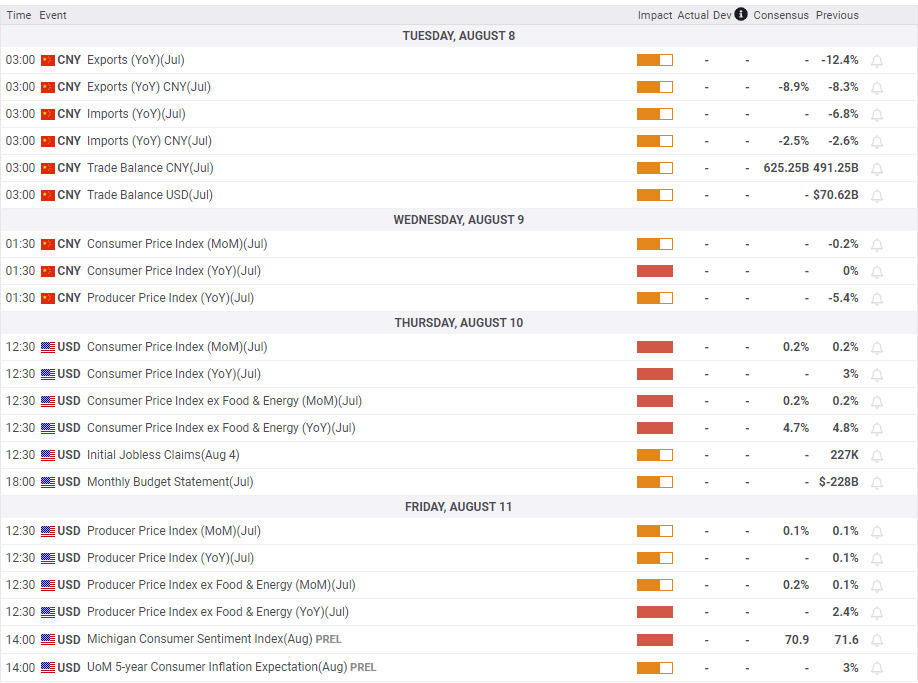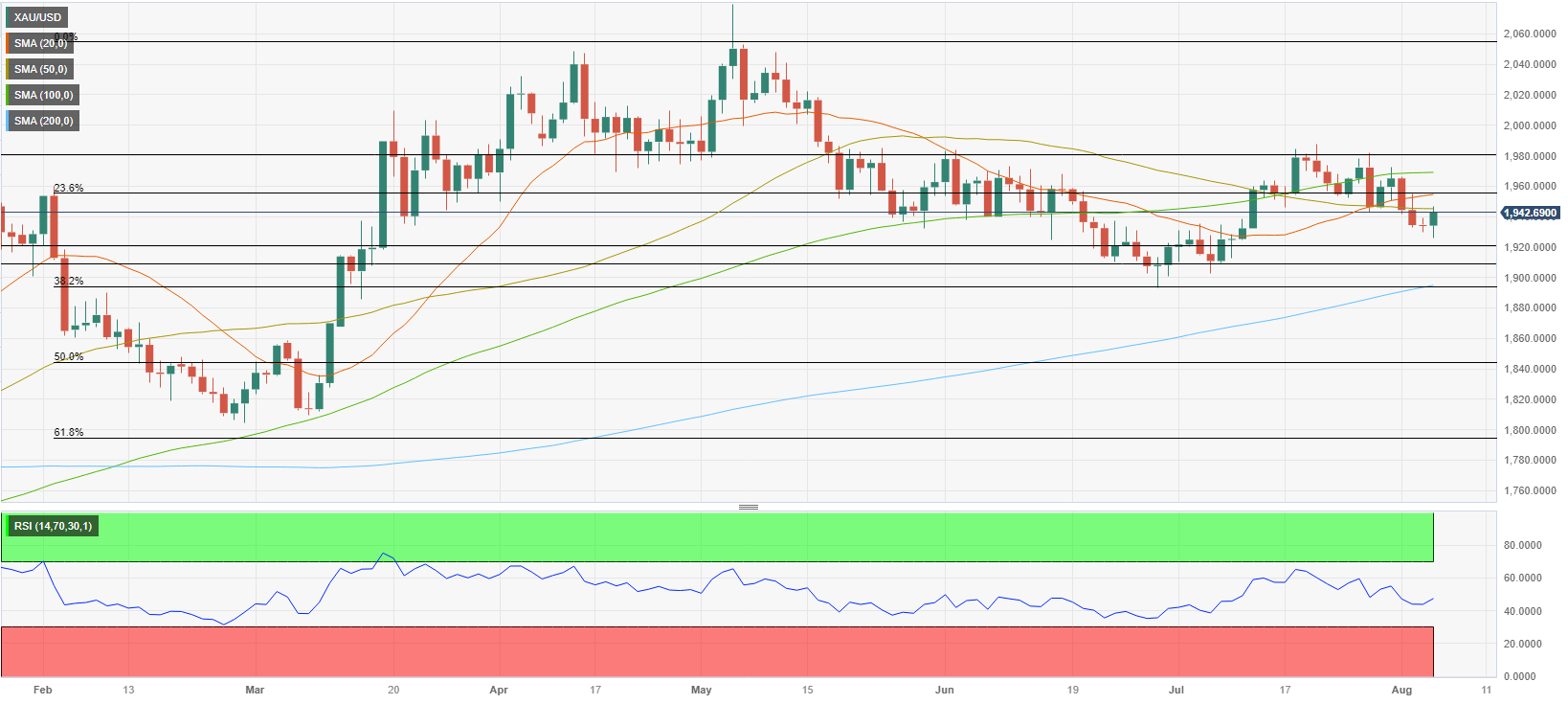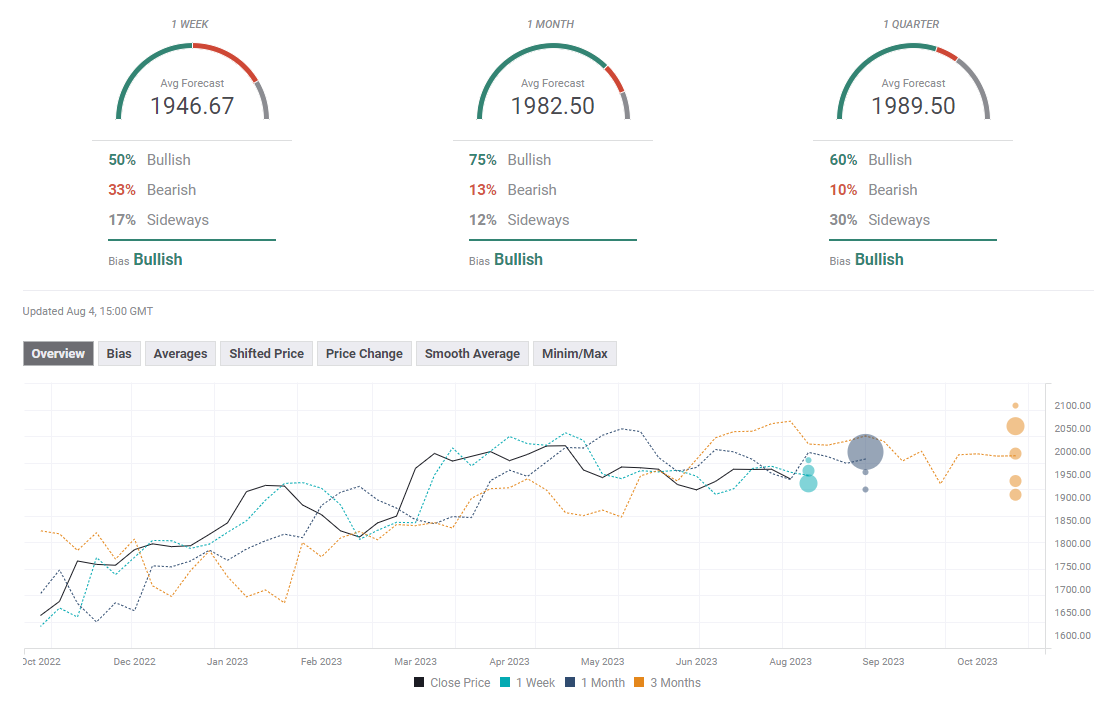- Gold price registered weekly losses despite Friday's rebound.
- Near-term technical outlook fails to provide a directional clue.
- July inflation data from the US will be watched closely by investors next week.
Following the previous Friday’s rebound, Gold price started the new week on a bullish note and climbed above $1,970 on Monday. Surging US Treasury bond yields, however, caused XAU/USD to reverse its direction later in the week. Although the pair managed to stage a rebound on Friday, it ended up closing the week in the red. July inflation data from the US will help investors decide whether Gold price could regain traction.
What happened last week?
In the absence of high-tier data releases on Monday, investors continued to react to the softer-than-expected US Personal Consumption Expenditures (PCE) Price Index data for July. The benchmark 10-year US Treasury bond yield declined below 4% and helped XAU/USD to build on last Friday’s recovery gains.
During the Asian trading hours on Tuesday, the data from China revealed that the economic activity in the manufacturing sector contracted in July, with the Caixin Manufacturing PMI dropping to 49.2 from 50.5. Gold price lost its traction and remained under modest bearish pressure in the European session. Later in the day, the US Dollar lost its strength after the ISM Manufacturing PMI came in at 46.4 in July, slightly worse than the market expectation of 46.8. Before the end of the day, however, Global rating agency Fitch announced that it downgraded the US government's credit rating to AA+ from AAA, citing anticipated fiscal deterioration over the next three years and a high and growing general government debt burden.
This development triggered an intense flight to safety mid-week, causing global equity indexes to decline sharply and providing a boost to the USD. The pair lost more than 1% on Tuesday and extended its slide in the second half of the week to a fresh three-week low below $1,930.
Other data from the US showed that the private sector employment rose by 324,000 in July. This reading surpassed the market expectation for an increase of 189,000 by a wide margin. In turn, the benchmark 10-year US Treasury bond yield climbed to its highest level since November above 4.1% and put additional weight on XAU/USD’s shoulders.
Meanwhile, World Gold Council said that their "outlook for 2023 is broadly unchanged: we expect investment demand to remain supported and central bank demand to remain positive, albeit lower than last year,” in its Gold Demand Trends report. “Fabrication demand, on the other hand, will likely come under pressure as inflation and recent high gold prices impact affordability.” The market reaction to this report remained relatively subdued.
On Thursday, mixed data releases from the US limited the USD’s upside, allowing XAU/USD to go into a consolidation phase. The ISM Services PMI declined to 52.7 from 53.9, compared to the market forecast of 53. The Employment Index of the survey fell to 50.7 from 53.1, while the Prices Paid Index climbed to 56.8 from 54.1, highlighting increasing input price pressures in the service sector. Finally, the number of first-time applications for unemployment benefits in the US rose to 227,000 in the week ending July 29, the US Department of Labor reported.
Nonfarm Payrolls (NFP) in the US rose 187,000 in July, compared to the market expectation of 200,000, the US Bureau of Labor Statistics announced on Friday. June’s increase of 209,000 got revised lower to 185,000. Other details of the jobs report showed that the annual wage inflation held steady at 4.4%, while the Unemployment Rate ticked down to 3.5% from 3.6% in June. The USD came under selling pressure and the 10-year US yield turned south after this data, allowing Gold price to recover back above $1,940 ahead of the weekend.
Next week
Chinese Trade Balance data will be watched closely by market participants on Tuesday. Investors are concerned about the Gold demand outlook amid growing signs of an economic slowdown in China, the world’s biggest consumer of Gold. A bigger-than-expected growth in China’s trade surplus – in USD terms – could help XAU/USD edge higher.
On Thursday, the US Bureau of Labor Statistics will release the Consumer Price Index (CPI) data for July. On a monthly basis, the Core CPI, which excludes volatile food and energy prices, and the CPI are both forecast to rise 0.2%. A big increase in the core figure, 0.4% or higher, could support the USD and weigh on XAU/USD.
Fed policymakers have been unusually quiet lately. Fedspeak after inflation data could also influence XAU/USD’s movements. Action in US Treasury bond yields could provide important clues whether markets assess Fed officials' comments as dovish or hawkish. The inverse correlation between the benchmark 10-year US yield and Gold price has been relatively strong lately. Hence, XAU/USD could turn north if the 10-year yield retreats below 4%. Conversely, the pair could find it difficult to shake off the bearish pressure in case the 10-year yield continues to stretch higher above 4%.
Gold technical outlook
The Relative Strength Index (RSI) on the daily chart recovered toward 50 ahead of the weekend, highlighting the lack of bearish momentum in XAU/USD. On the upside, immediate resistance for the pair is located in the $1,950/$1,955 area, where the Fibonacci 23.6% retracement level of the long-term uptrend and the 20-day Simple Moving Average (SMA) align. Above that region, the pair is likely to face stiff resistance at $1,970 (100-day SMA) and $1,980 (static level) before targeting $2,000.
Looking south, $1,920 (static level) stays intact as near-term support. Once XAU/USD falls below that level, it could encounter interim support at $1,910 (static level) on its way to test $1,900 (psychological level, Fibonacci 38.2% retracement, 200-day SMA).
Gold forecast poll
FXStreet Forecast Poll points to a mixed outlook in the near term, with the one-week average target aligning slightly below $1,950. The one-month outlook remains overwhelmingly bullish, with a majority of polled experts seeing Gold price rising to $2,000.
Information on these pages contains forward-looking statements that involve risks and uncertainties. Markets and instruments profiled on this page are for informational purposes only and should not in any way come across as a recommendation to buy or sell in these assets. You should do your own thorough research before making any investment decisions. FXStreet does not in any way guarantee that this information is free from mistakes, errors, or material misstatements. It also does not guarantee that this information is of a timely nature. Investing in Open Markets involves a great deal of risk, including the loss of all or a portion of your investment, as well as emotional distress. All risks, losses and costs associated with investing, including total loss of principal, are your responsibility. The views and opinions expressed in this article are those of the authors and do not necessarily reflect the official policy or position of FXStreet nor its advertisers. The author will not be held responsible for information that is found at the end of links posted on this page.
If not otherwise explicitly mentioned in the body of the article, at the time of writing, the author has no position in any stock mentioned in this article and no business relationship with any company mentioned. The author has not received compensation for writing this article, other than from FXStreet.
FXStreet and the author do not provide personalized recommendations. The author makes no representations as to the accuracy, completeness, or suitability of this information. FXStreet and the author will not be liable for any errors, omissions or any losses, injuries or damages arising from this information and its display or use. Errors and omissions excepted.
The author and FXStreet are not registered investment advisors and nothing in this article is intended to be investment advice.
Recommended Content
Editors’ Picks

EUR/USD trims losses and approaches 1.1380
The US Dollar now succumbs to the re-emergence of the selling pressure and allows EUR/USD to recoup part of the ground lost and approach to the 1.1380 zone on Thursday. Earlier on Thursday, the ECB matched estimates and lowered its rates by 25 bps.

GBP/USD extends the daily recovery, looks at 1.3300
The upside impulse in the British pound remains everything but abated and now propels GBP/USD to the upper end of the range, shifting its attention to recent yearly peaks near 1.3300 the figure.

Gold breaks below $3,300, daily troughs
Further improvement in the sentiment surrounding the risk-associated universe put Gold prices to the test on Thursday. Indeed, the troy ounce of the precious metal faces increasing downside pressure and breaches the key $3,300 mark to hit new daily lows.

Crypto market cap fell more than 18% in Q1, wiping out $633.5 billion after Trump’s inauguration top
CoinGecko’s Q1 Crypto Industry Report highlights that the total crypto market capitalization fell by 18.6% in the first quarter, wiping out $633.5 billion after topping on January 18, just a couple of days ahead of US President Donald Trump’s inauguration.

Future-proofing portfolios: A playbook for tariff and recession risks
It does seem like we will be talking tariffs for a while. And if tariffs stay — in some shape or form — even after negotiations, we’ll likely be talking about recession too. Higher input costs, persistent inflation, and tighter monetary policy are already weighing on global growth.

The Best brokers to trade EUR/USD
SPONSORED Discover the top brokers for trading EUR/USD in 2025. Our list features brokers with competitive spreads, fast execution, and powerful platforms. Whether you're a beginner or an expert, find the right partner to navigate the dynamic Forex market.


